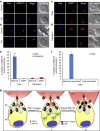Triggers of key calcium signals during erythrocyte invasion by Plasmodium falciparum
- PMID: 24280897
- PMCID: PMC3868333
- DOI: 10.1038/ncomms3862
Triggers of key calcium signals during erythrocyte invasion by Plasmodium falciparum
Abstract
Invasion of erythrocytes by Plasmodium falciparum merozoites is a complex multi-step process mediated by specific interactions between host receptors and parasite ligands. Reticulocyte-binding protein homologues (RHs) and erythrocyte-binding-like (EBL) proteins are discharged from specialized organelles and used in early steps of invasion. Here we show that monoclonal antibodies against PfRH1 (an RH) block merozoite invasion by specifically inhibiting calcium signalling in the parasite, whereas invasion-inhibiting monoclonal antibodies targeting EBA175 (an EBL protein) have no effect on signalling. We further show that inhibition of this calcium signalling prevents EBA175 discharge and thereby formation of the junction between parasite and host cell. Our results indicate that PfRH1 has an initial sensing as well as signal transduction role that leads to the subsequent release of EBA175. They also provide new insights on how RH-host cell interactions lead to essential downstream signalling events in the parasite, suggesting new targets for malaria intervention.
Figures






Similar articles
-
Distinct external signals trigger sequential release of apical organelles during erythrocyte invasion by malaria parasites.PLoS Pathog. 2010 Feb 5;6(2):e1000746. doi: 10.1371/journal.ppat.1000746. PLoS Pathog. 2010. PMID: 20140184 Free PMC article.
-
Few Plasmodium falciparum merozoite ligand and erythrocyte receptor pairs show evidence of balancing selection.Infect Genet Evol. 2019 Apr;69:235-245. doi: 10.1016/j.meegid.2019.02.004. Epub 2019 Feb 5. Infect Genet Evol. 2019. PMID: 30735814 Free PMC article.
-
A processing product of the Plasmodium falciparum reticulocyte binding protein RH1 shows a close association with AMA1 during junction formation.Cell Microbiol. 2020 Sep;22(9):e13232. doi: 10.1111/cmi.13232. Epub 2020 Jun 17. Cell Microbiol. 2020. PMID: 32452132
-
Cytoskeletal and membrane remodelling during malaria parasite invasion of the human erythrocyte.Br J Haematol. 2011 Sep;154(6):680-9. doi: 10.1111/j.1365-2141.2011.08766.x. Epub 2011 Jul 1. Br J Haematol. 2011. PMID: 21718279 Review.
-
Overlaying Molecular and Temporal Aspects of Malaria Parasite Invasion.Trends Parasitol. 2016 Apr;32(4):284-295. doi: 10.1016/j.pt.2015.12.007. Epub 2016 Jan 7. Trends Parasitol. 2016. PMID: 26778295 Review.
Cited by
-
The malaria parasite Plasmodium falciparum in red blood cells selectively takes up serum proteins that affect host pathogenicity.Malar J. 2020 Apr 15;19(1):155. doi: 10.1186/s12936-020-03229-1. Malar J. 2020. PMID: 32295584 Free PMC article.
-
The central role of cAMP in regulating Plasmodium falciparum merozoite invasion of human erythrocytes.PLoS Pathog. 2014 Dec 18;10(12):e1004520. doi: 10.1371/journal.ppat.1004520. eCollection 2014 Dec. PLoS Pathog. 2014. PMID: 25522250 Free PMC article.
-
Host-parasite interactions that guide red blood cell invasion by malaria parasites.Curr Opin Hematol. 2015 May;22(3):220-6. doi: 10.1097/MOH.0000000000000135. Curr Opin Hematol. 2015. PMID: 25767956 Free PMC article. Review.
-
Inside scoop on outside proteins.Infect Immun. 2014 Mar;82(3):921-3. doi: 10.1128/IAI.01542-13. Epub 2013 Dec 16. Infect Immun. 2014. PMID: 24343655 Free PMC article.
-
Molecular Signaling Involved in Entry and Exit of Malaria Parasites from Host Erythrocytes.Cold Spring Harb Perspect Med. 2017 Oct 3;7(10):a026815. doi: 10.1101/cshperspect.a026815. Cold Spring Harb Perspect Med. 2017. PMID: 28507195 Free PMC article. Review.
References
-
- Cowman A. F. & Crabb B. S. Invasion of red blood cells by malaria parasites. Cell 124, 755–766 (2006). - PubMed
-
- Baum J., Gilberger T. W., Frischknecht F. & Meissner M. Host-cell invasion by malaria parasites: insights from Plasmodium and Toxoplasma. Trends Parasitol. 24, 557–563 (2008). - PubMed
-
- Gaur D. & Chitnis C. E. Molecular interactions and signalling mechanisms during erythrocyte invasion by malaria parasites. Curr. Opin. Microbiol. 14, 422–428 (2011). - PubMed
-
- Gunalan K., Gao X., Yap S. S., Huang X. & Preiser P. R. The role of the reticulocyte-binding-like protein homologues of Plasmodium in erythrocyte sensing and invasion. Cell Microbiol. 15, 35–44 (2013). - PubMed
Publication types
MeSH terms
Substances
LinkOut - more resources
Full Text Sources
Other Literature Sources

